I like to call them the “bumbling pilots of the garden,” and every summer, those loud, buzzy, clumsy fig beetles are quite an amusing sight to see.
If they’re not, ahem, getting down to business, they’re firmly planted on fruit trees, sucking the juice of not only their namesake figs, but other soft-skinned, rotting fruits on your trees, vines, and shrubs.
Fig beetles aren’t destructive to the garden the way other pests are; they won’t spread diseases, kill your trees, or attract more pests.
Recommended reading: Get Rid of Aphids Naturally With These 9 Easy Solutions
In fact, consider yourself lucky if fig beetles are the extent of your pest problems! Some people welcome them as harbingers of warm summer days and garden bounties to come.
But, they can actually lessen your garden bounty and be a nuisance if they’re feeding on your crop before you get around to harvesting it.
I used to battle figeater beetles in my garden every summer until I learned a few simple tricks to get rid of fig beetles organically and keep their populations in check. I’ll show you how!
What is a fig beetle?
Fig beetles (Cotinis mutabilis, also known as figeater beetles or green fruit beetles) are members of the scarab beetle family.
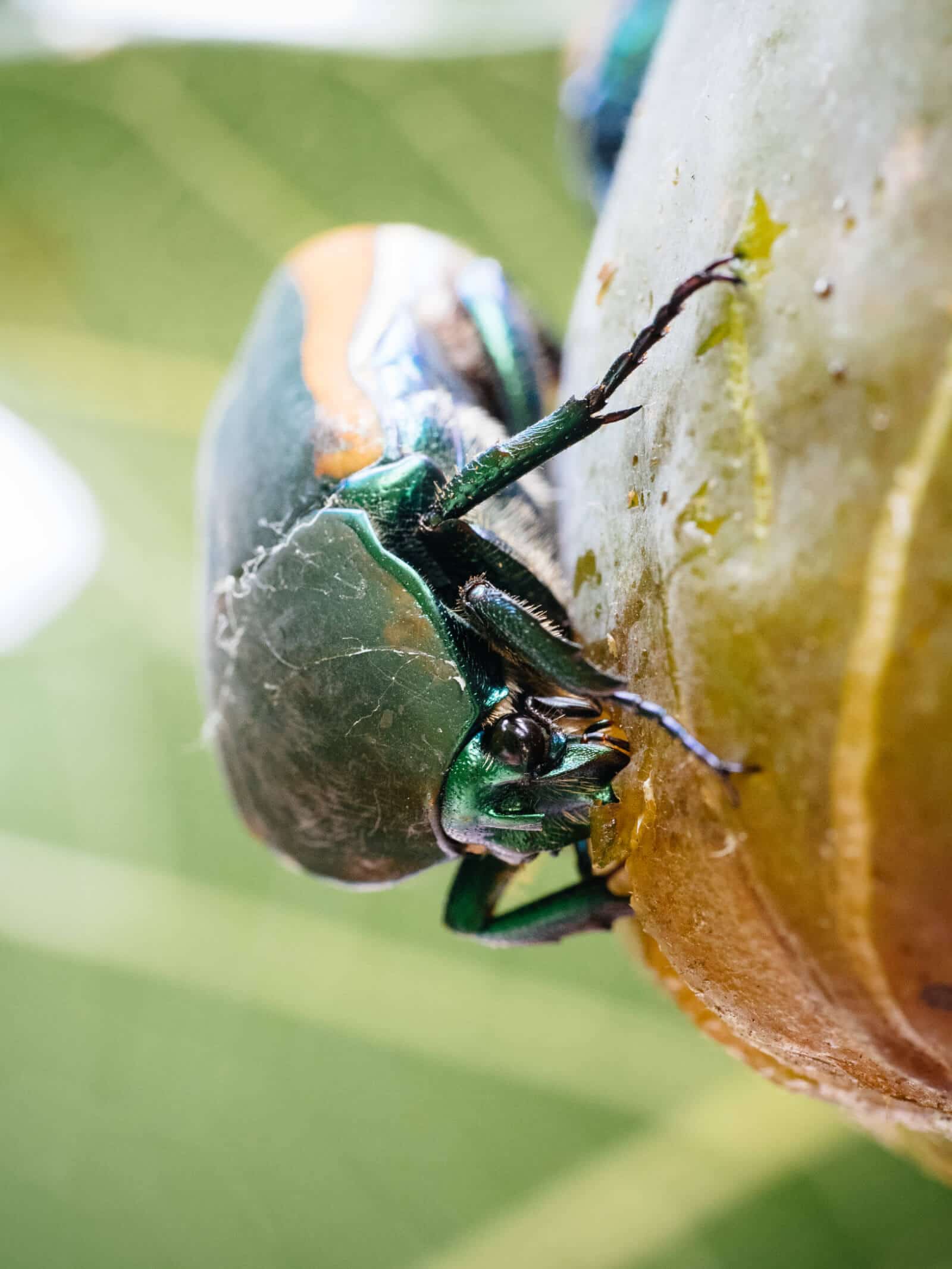
They’re easily recognizable by their beautifully distinctive coloration. Fig beetles are metallic dark green on top with a tan-colored band edging their forewings (known as elytra), and have iridescent green legs and undersides.
Adult fig beetles are relatively large as far as insects go, and vary from 3/4 inch to 1 1/2 inches long.
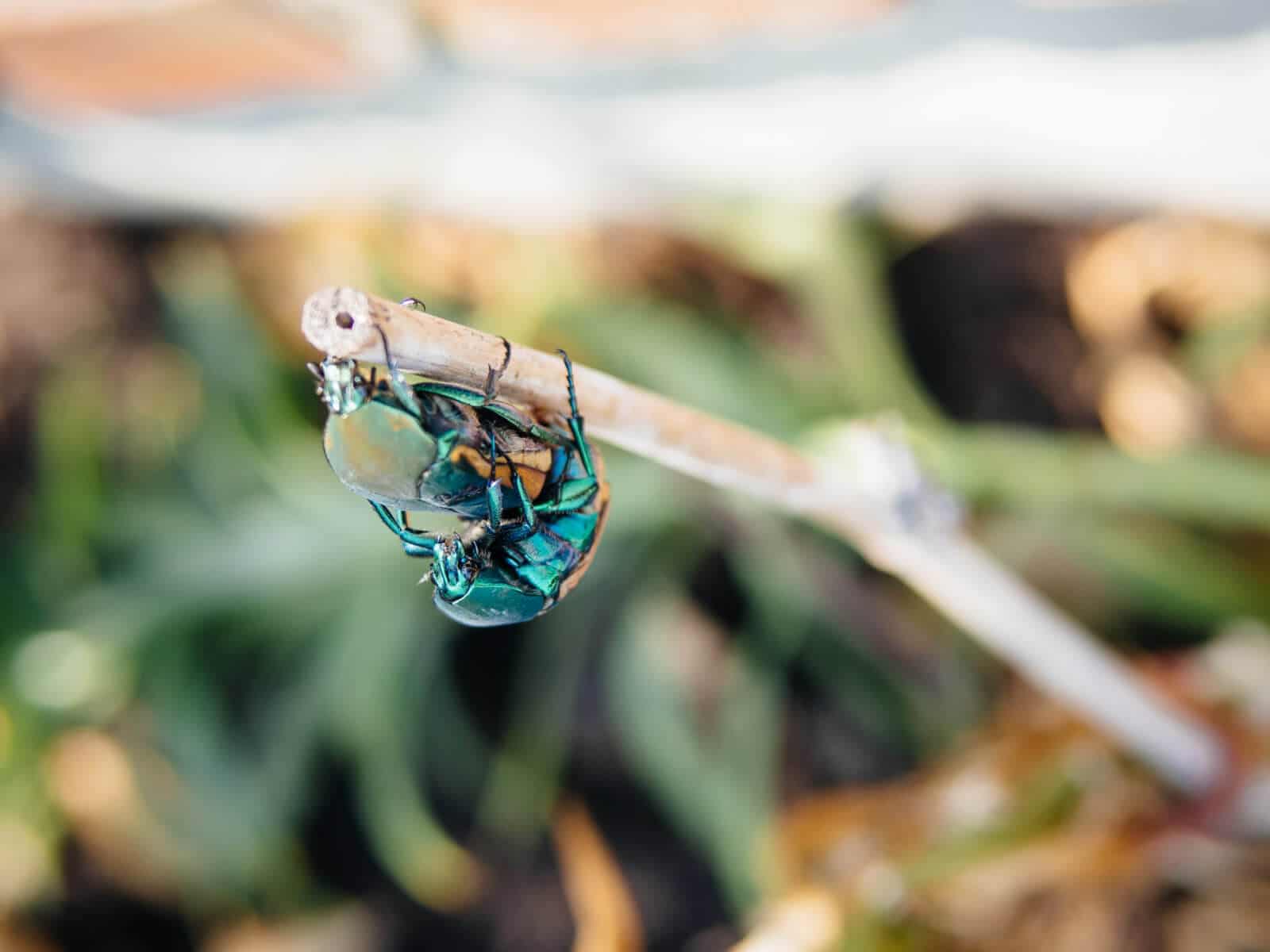
Fig beetles have one generation per year, though they can remain in the soil for up to two years. The larvae emerge from the eggs in fall and overwinter in mulch, compost, manure, or any decaying pile of organic materials.
The larvae, or “crawly backs,” look like curled up, creamy white grubs and don’t do any damage to lawns or gardens, as they solely feed on organic matter in the soil.
They are excellent decomposers that help your compost break down more quickly, and are right up there with soil fungi and bacteria as essential “recyclers” in the ecosystem.
In spring, the second larval stage begins. After metamorphosis, the grubs emerge as winged adults in summer. This is when fig beetles are most active, as they fly in low, lazy circles around the yard, searching for mates and feeding on fruits.
Their mouths are actually very weak, making them ineffective at chewing on most plant materials. They always seek out overripe fruits that have split, or fruits that have already been damaged by other insects, birds, or squirrels, especially those with thin skins and extra soft flesh.
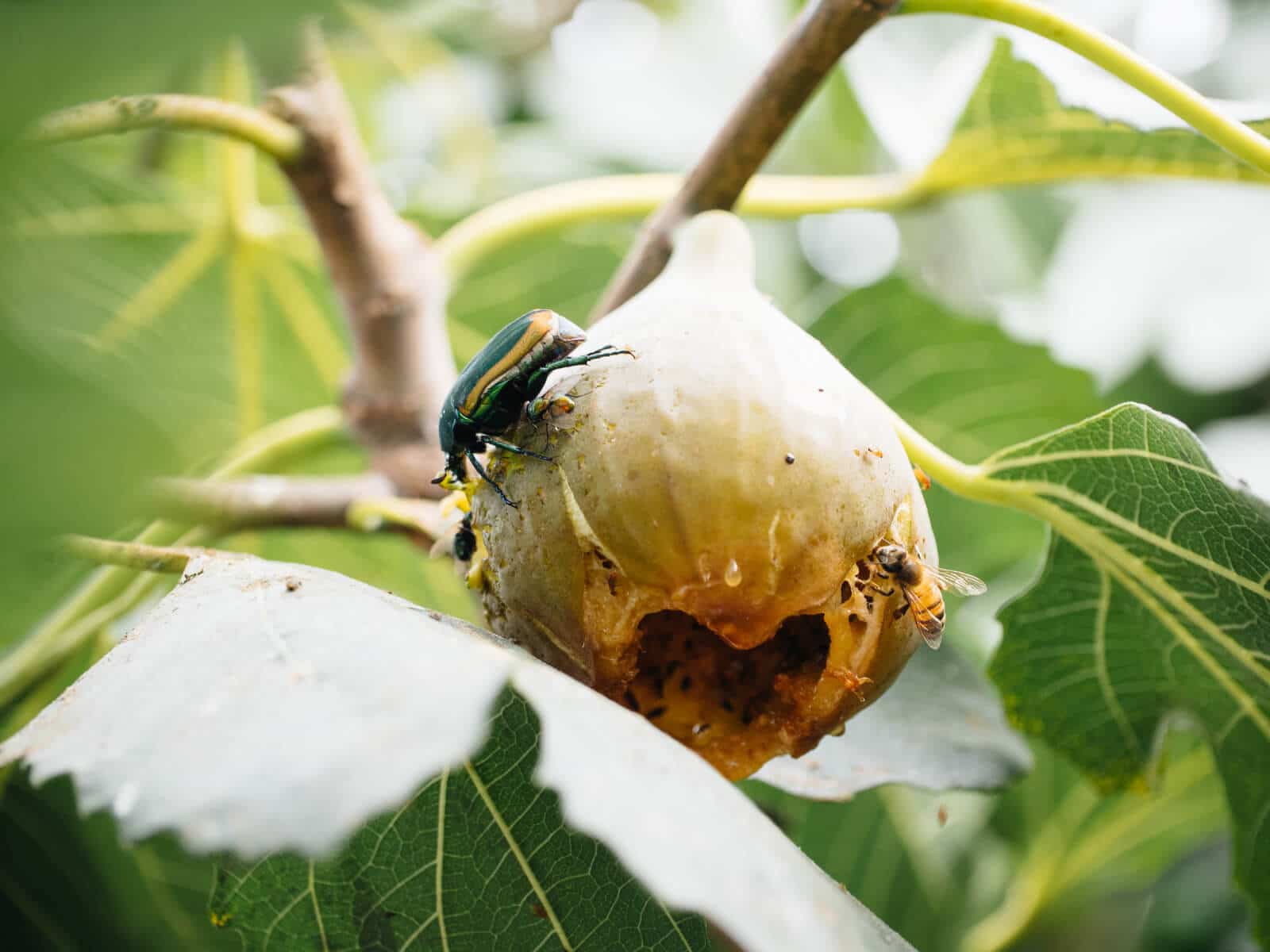
Fig beetles are most active in the middle of the day, and you’ll usually hear them coming (or, more like dive bombing!) before you can see them.
They make bumblebee-like buzzing sounds as they fly. These sounds come from their elytra (hardened forewings, similar to those found on ladybugs), which are partially closed in flight and only barely raised during takeoff.
Contrary to popular belief, figeater beetles are not blind. Due to the way they function, their partially open elytra makes them notoriously slow and drunk-like as they navigate the air. It’s not uncommon to see fig beetles crashing into walls, trees, and even humans when they fly!
Though it’s somewhat of a shock the first time it happens, colliding with a fig beetle is no cause for alarm—they’re as gentle as can be and do not bite or attack.
Where are fig beetles commonly found?
Fig beetles are native to the southwestern United States and Mexico. Originally, they were limited to Arizona, New Mexico, Texas, and Northern Mexico, but by the 1960s they’d increased their range and began appearing in coastal Southern California.
Today, their populations extend farther up the coast of Central California and into the Central Valley.
It’s believed that fig beetles have increased along with the spread of home gardens, which offer an abundance of food for adult beetles, as well as yard compost and mulch piles that feed and shelter beetle larvae.
What are fig beetles attracted to?
If you don’t have fruiting trees or shrubs in your yard, then chances are you’ll rarely encounter a fig beetle.
The pests are attracted to soft, thin-skinned fruits like figs, peaches, plums, pears, cherries, apricots, grapes, berries, and even cactus fruits. These types of fruits are easy to sink their mouthparts into, especially if they’re left to overripen on the plant. If you have banana trees and let your bananas turn yellow or brown on the bunch, you might also find fig beetles swarming an extra sweet and extra soft split banana. They love damaged or rotting fruit!
But in the absence of fruit, fig beetles will go for anything sweet, including plant pollen, nectar, and sap.
Fig beetle look-alikes
Fig beetles are often mistaken for Japanese beetles (Popillia japonica) or green June beetles (Cotinis nitida, also known as June bugs).

While they may look similar, Japanese beetles and June beetles are slightly smaller, have a browner, more coppery appearance, and are only found in the southern and eastern United States from Texas to New York.
How to control fig beetles naturally
Fig beetles can be annoying, but they’re unlikely to do any significant damage in the garden.
If you want to get rid of fig beetles naturally, the key is to take preventive measures first, as chemical controls often don’t work on them, and agricultural resources (like University of California’s Integrated Pest Management program) don’t recommend using them.
(You also don’t want to be spraying your ripe fruits with anything right before you pick them.)
Fig beetles are active from July through September when food sources are at their peak, so start early if you want to control them most effectively.
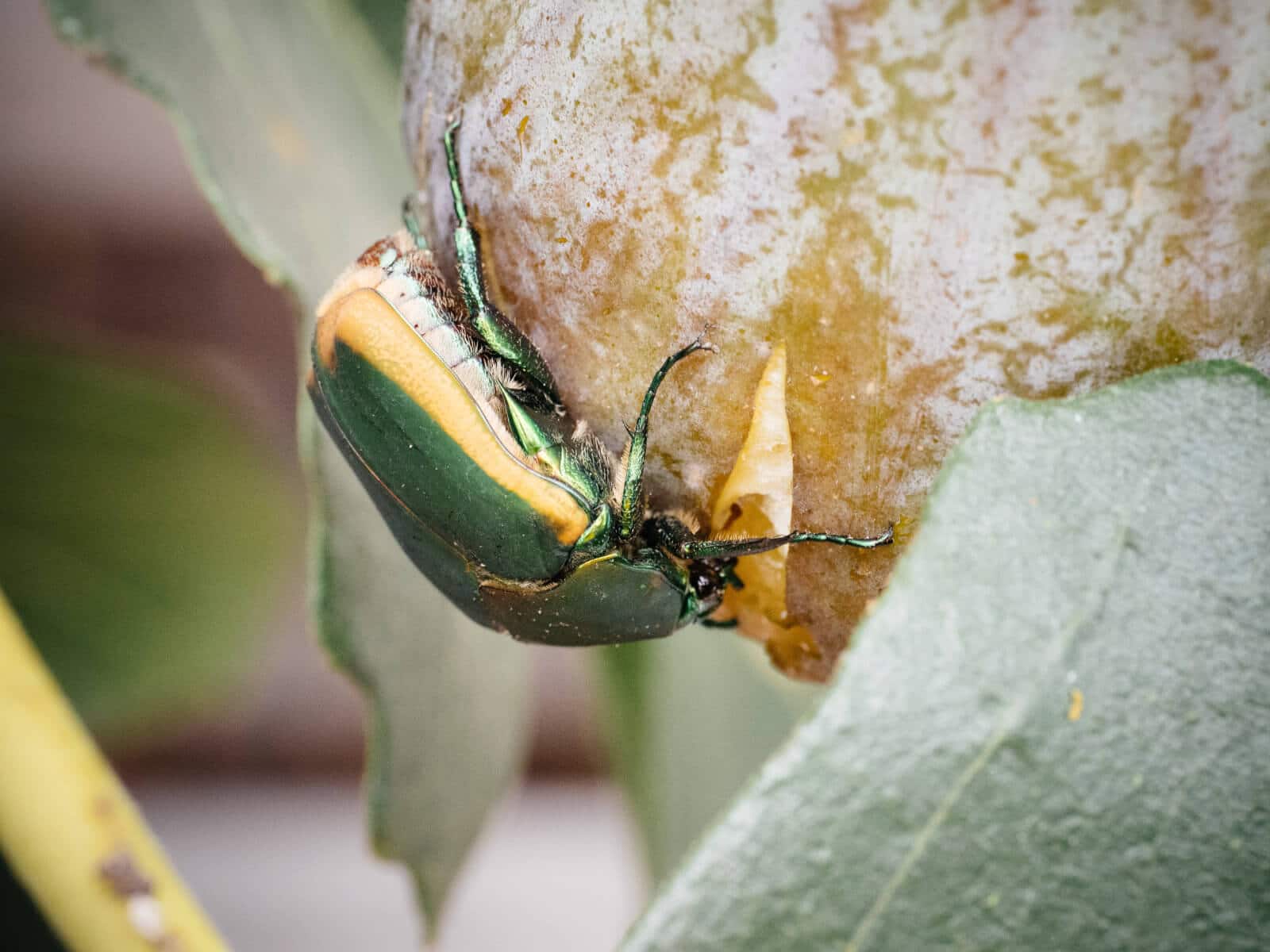
1. Control during the larval stage.
To reduce fig beetle populations in the summer, control them when they’re most vulnerable in the larval stage.
Since the grubs live in and thrive on decaying matter, turn over any piles of mulch, compost, leaf litter, grass clippings, and animal manure frequently in spring.
These materials (their favorite breeding grounds) provide food and shelter for the grubs. By being exposed, they’re likely to be swooped up by birds, skunks, opossums, raccoons, and other predators (while hopefully sparing the rest of your garden from these foragers as well).
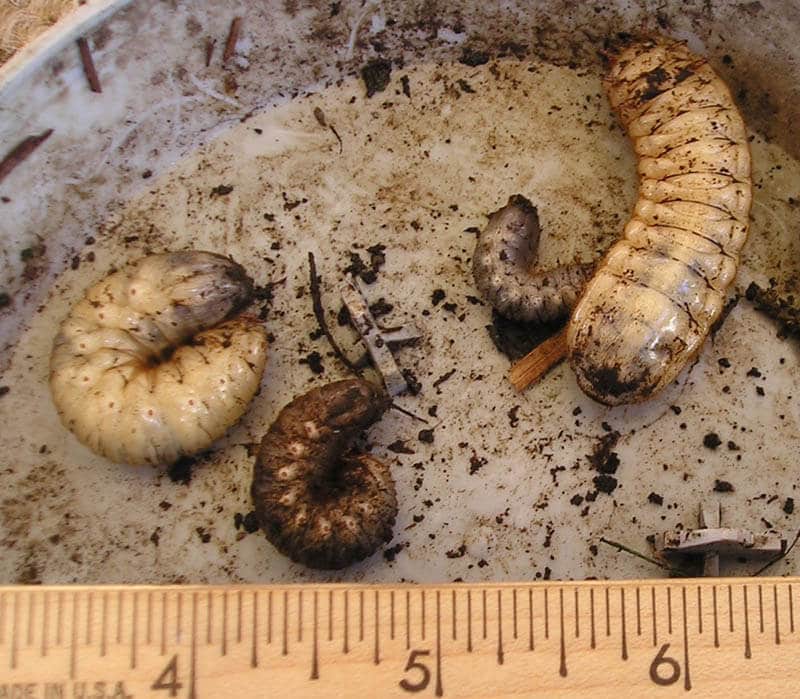
2. Remove their food sources.
Fig beetles are attracted to soft, mushy, damaged fruit, so pick all your fruits as soon as they ripen, remove any that have been nibbled on by other pests, and don’t let lots of fruit rot on the ground.
Leaving a juicy, dripping fig (or any other fruit) on a branch is just an invitation for clusters of figeater beetles to descend on your tree and feed all day, living up to their name.
In peak season, try to make a habit of picking your fruit daily. This will keep fig beetles out of your garden and leave more fruits for you to enjoy.
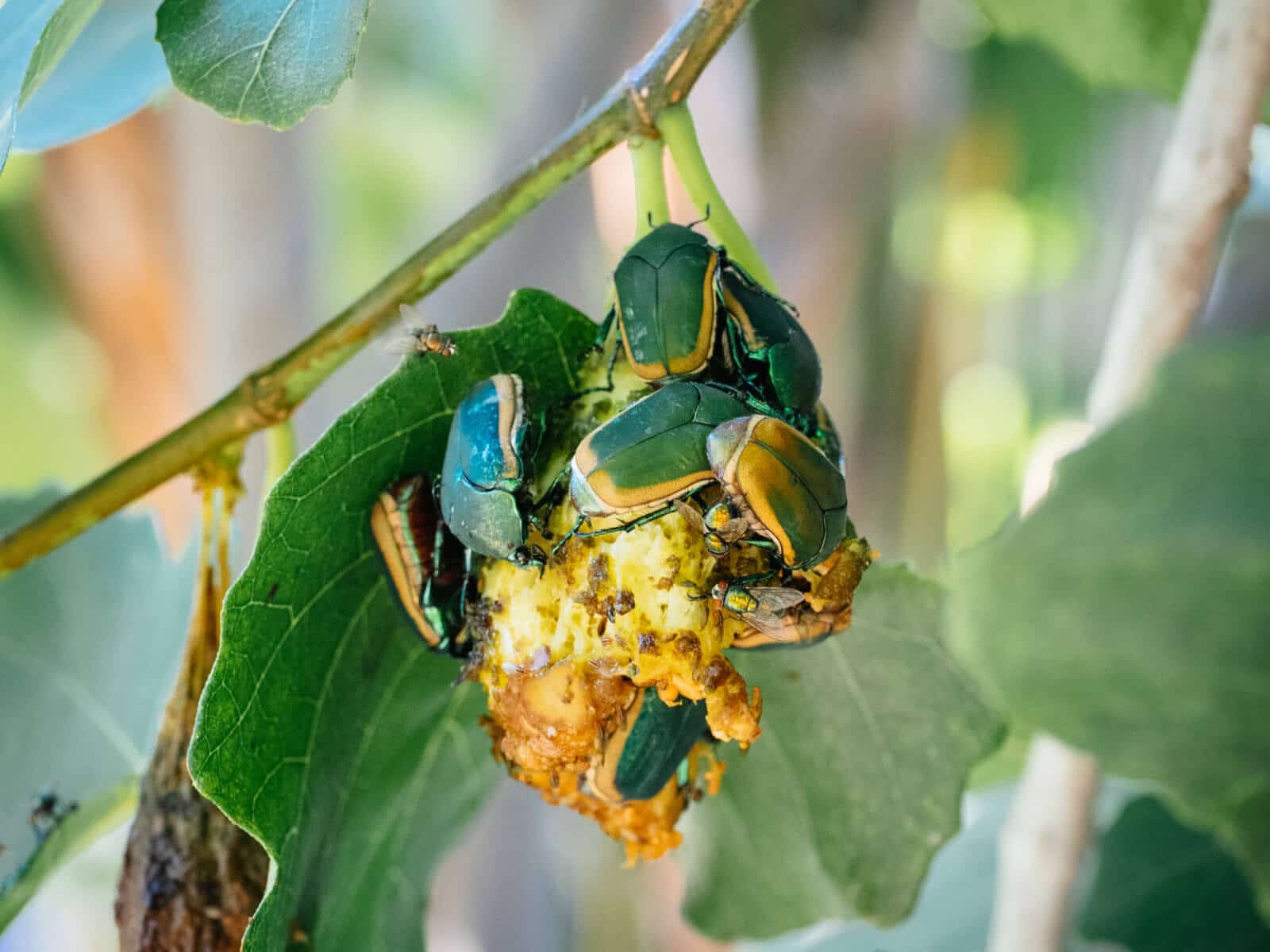
Disclosure: If you shop from my article or make a purchase through one of my links, I may receive commissions on some of the products I recommend.
3. Use physical barriers on your fruit trees and shrubs.
If you can’t get around to harvesting your fruits as often as you should, consider covering your trees and shrubs with a physical barrier (like this lightweight floating row cover or this insect netting), which will keep fig beetles, birds, and other pests off your fruits.
Remember that any barrier will also prevent pollinators from reaching the flowers, so place the covering just before the fruits start to mature.
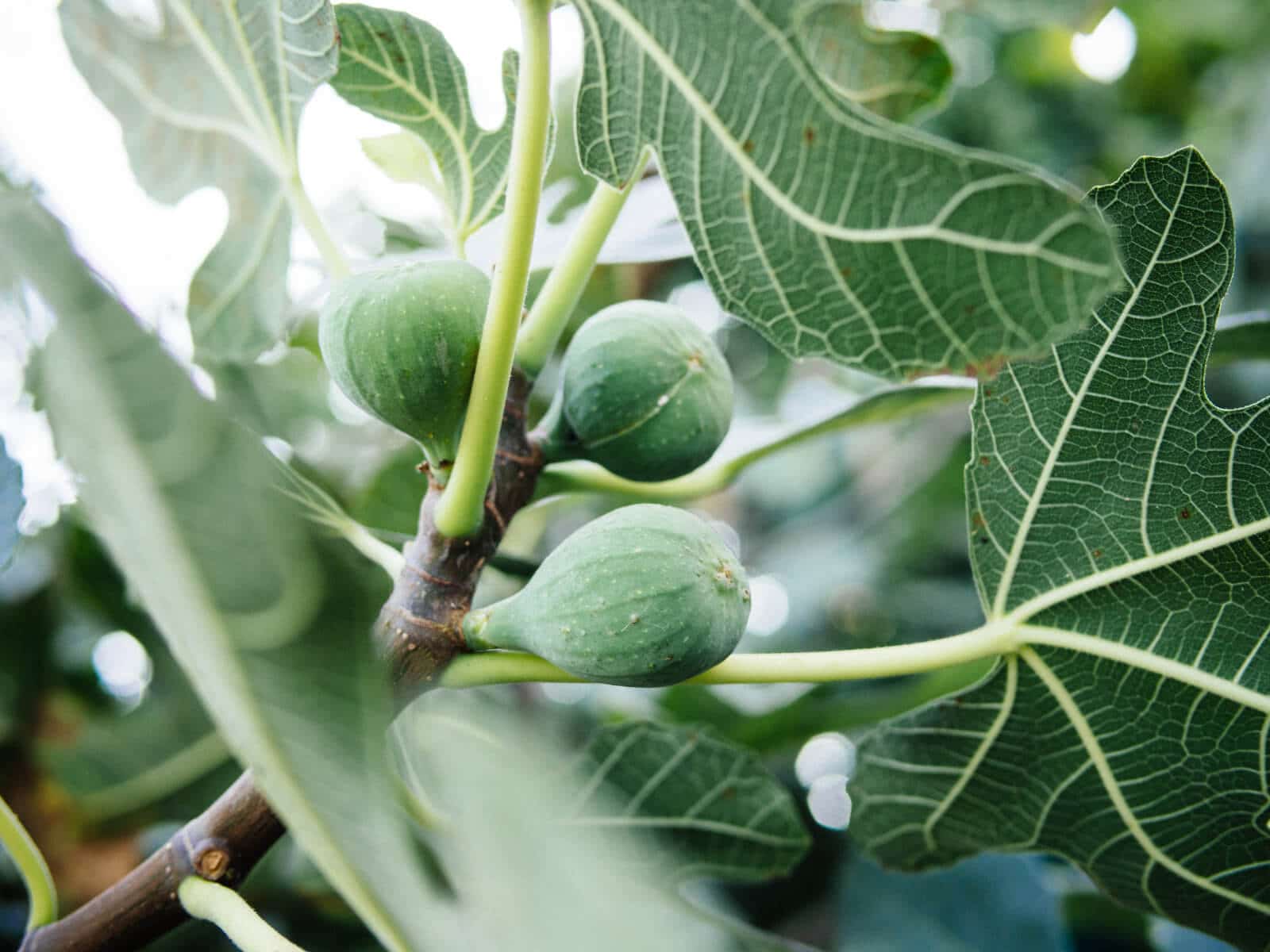
4. Hand-pick fig beetles as you find them.
To eliminate fig beetles the old-fashioned way, hand-pick each one and drop it into a bucket of soapy water. Dish soap works fine for this, and it doesn’t take much to kill them (a few squirts is all you need).
Once you’ve drowned all the fig beetles, dump them into your compost pile.
If there are multiple fig beetles swarming a single piece of fruit, place a mason jar underneath and snip the fruit off the branch. (Sometimes I’ll sacrifice a piece of fruit this way in order to trap fig beetles more effectively.)
The fig beetles (and fruit) will fall into the jar, and you can quickly dump them out into a bucket of soapy water from there.
5. Make a bottle trap to lure fig beetles.
You can DIY a simple bottle trap to attract and catch fig beetles in your garden.
There are many variations of homemade bottle traps, but the easiest one to make only requires a soda bottle and some bait.
Remove the cap and cut the top 4 to 5 inches (right above the label) off a 2-liter plastic soda bottle. Invert the top and place it inside the bottle like a funnel. If needed, tape the two sections together (though they should fit snugly).
Bait the trap with a 1:1 mixture of fruit juice (grape or apple) and water. Pour a few inches of this mixture into the bottle, and hang a trap on each tree that’s affected. (If there’s a really bad infestation, hang two or three traps per tree.)
I use a heavy-duty hole punch and twine to hang my trap, but you can also poke holes into the plastic using a nail and then thread a piece of string through them.
Fig beetles will be attracted to the sweet liquid and land in the funnel. Once inside, they’ll be unable to escape. You can dump the beetles into a bucket of soapy water to drown them, then reassemble and re-bait the bottle trap as needed.
6. Feed them to your chickens.
If you raise backyard chickens, fig beetles are a dream treat come true for them! You can capture several fig beetles using the jar method mentioned above, then toss them out into the chicken run for your flock.
Read more: Fig Beetles: Bumbling Pilots of the Garden
If your chickens like to forage around your fruit trees, you can also bat the fig beetles down to the ground with your hand and let your ladies chase after and enjoy them.
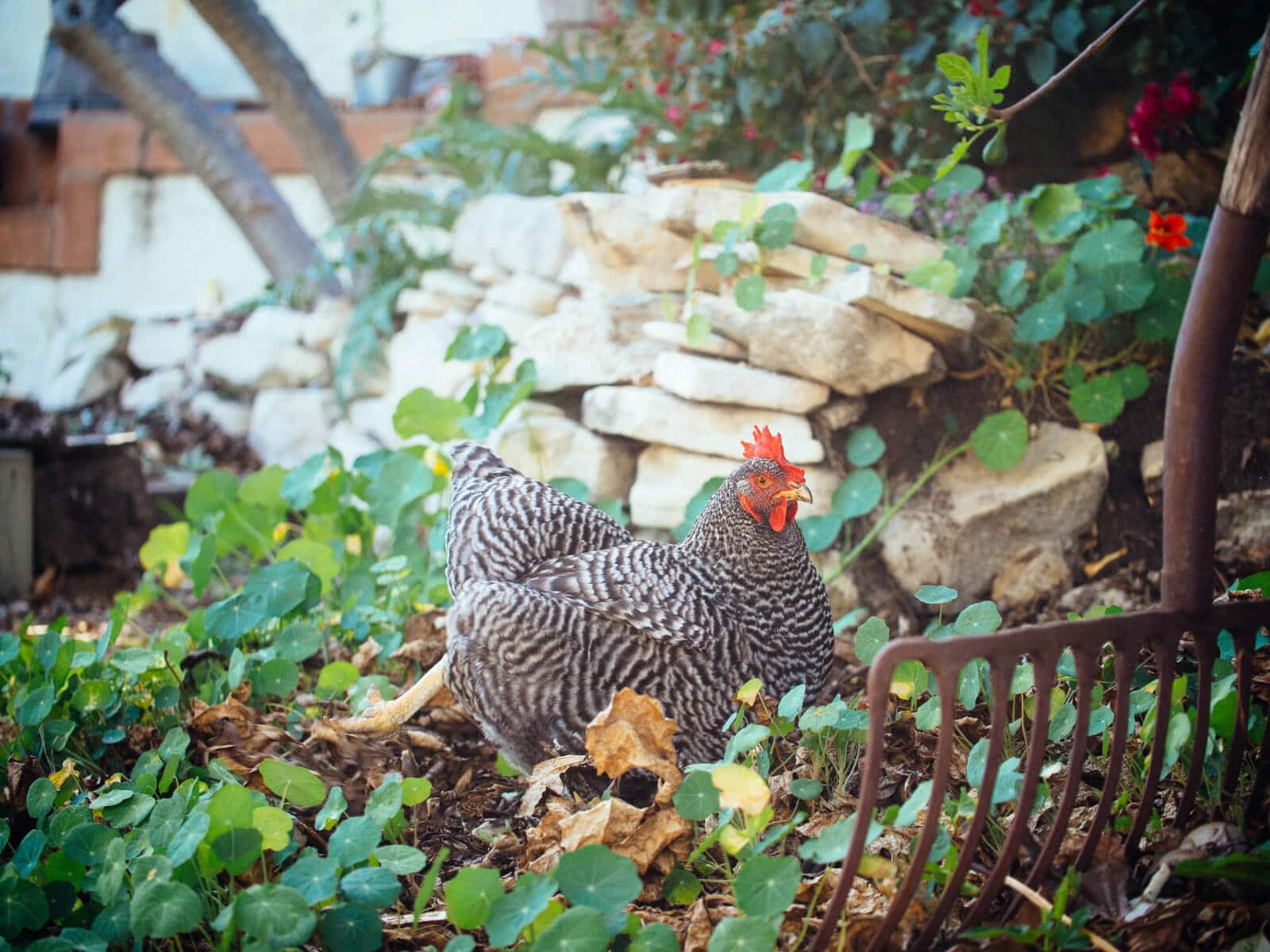
Chickens also make excellent compost turners, so in spring, let them peck and scratch through your mulch and compost heap for grubs. You nip the problem in the bud early, and your chickens are well-fed and happy. Win-win!
This post updated from an article that originally appeared on September 5, 2019.
View the Web Story on how to get rid of fig beetles.


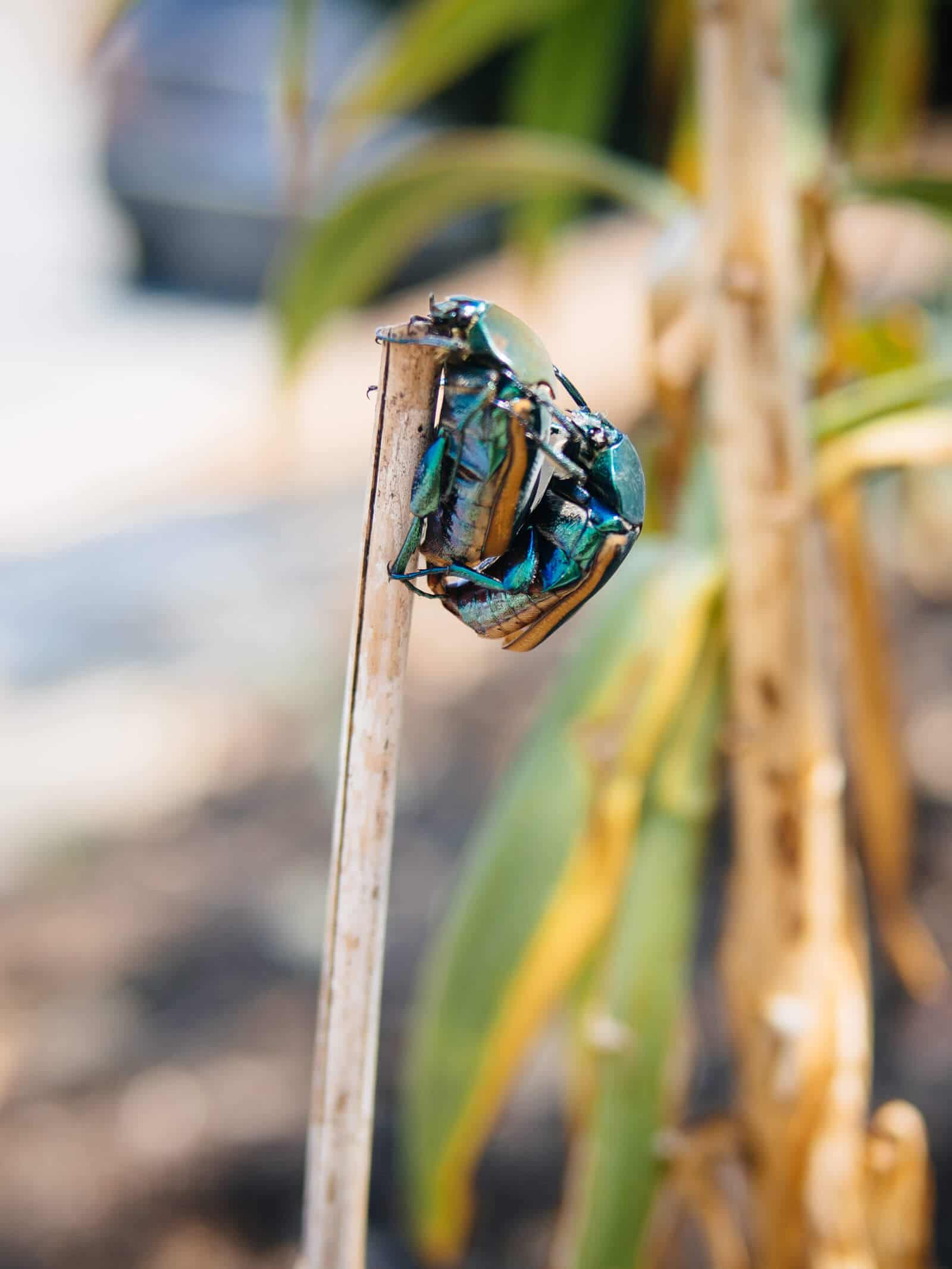













Milky spore disease will after a year or two get rid if them for about 20 years. MS does not harm a ything but grubs